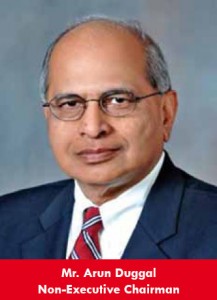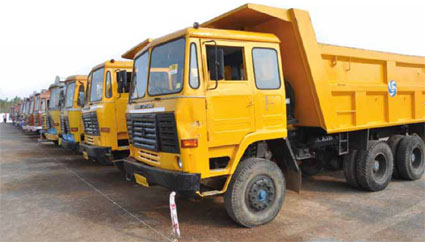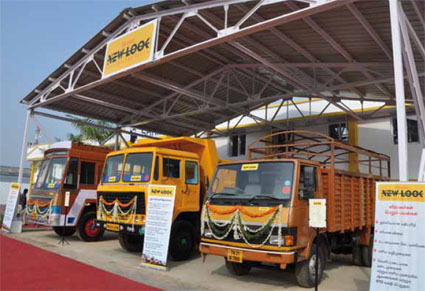Pre-owned vehicles account for 70% of India’s CV sales
 Commercial vehicle financing is perhaps the oldest retail financing segment in the country. It is a highly fragmented segment because though there are a large number of people buying trucks, most of them have poor banking habits. So unorganised money lenders meet the financing needs of several buyers of used trucks.
Commercial vehicle financing is perhaps the oldest retail financing segment in the country. It is a highly fragmented segment because though there are a large number of people buying trucks, most of them have poor banking habits. So unorganised money lenders meet the financing needs of several buyers of used trucks.
The CV financing market in India is estimated to be more than Rs. 100,000 crores with vehicles more than five years old accounting for half of it. STFC has been a leader in the organised financing of pre-used trucks for over three decades. The company has carved a niche for itself by catering to one of the most potential yet apparently ignored segments in the country.
Established in 1979, Shriram Transport Finance Co Ltd. (STFC) is the largest asset financing NBFC with assets under management of Rs. 40,213.90 crores. The company is a leader in organised financing of pre-owned trucks with strategic presence in 5-12 year old trucks and a market share of around 25 per cent. It has a pan-India presence with a network of 502 branches along with over 500 private financiers, and has built a strong customer base of over 8.5 lakhs.
 Used or pre-owned vehicles account for almost 70 per cent of the total commercial vehicle sales in the country. Small road transport operators, who typically own less than five trucks, largely control the freight movement on road. And everyday more people join this expanding group of truck entrepreneurs, and mostly their first buy is a used vehicle. On an average, a commercial vehicle is resold three times during its operational lifecycle of approximately 12 years.
Used or pre-owned vehicles account for almost 70 per cent of the total commercial vehicle sales in the country. Small road transport operators, who typically own less than five trucks, largely control the freight movement on road. And everyday more people join this expanding group of truck entrepreneurs, and mostly their first buy is a used vehicle. On an average, a commercial vehicle is resold three times during its operational lifecycle of approximately 12 years.
A major challenge faced by buyers and financiers of used vehicles is lack of established platforms for trading such vehicles and proper asset valuation norms. This harbours a perception of increased risk with the financiers. However, an encouraging sign is that yields are much higher than on new vehicle financing and the loan tenure is much less. Also, there is room for penetration by organised companies as the segment is currently dominated by unorganised players.
Challenging FY12
The year 2011-12 was marked by tightening liquidity and higher cost of funds leading to a negative impact on infrastructure investments and deferred investment plans. But inflation was kept under control since October last year, while the Reserve Bank of India had eased its tight monetary policy by cutting the short-term lending rate for the first time in more than two years.
 Commercial vehicle sales in India increased by 18.2 per cent year-on-year in 2011-12, but sales of medium and heavy commercial vehicles (M&HCVs) rose by just 7.9 per cent as compared to 37.2 per cent in 2010-11. This decline was on account of high interest rates on loans, cut in industrial production and a hike in vehicle prices. Several fleet operators applied brake on their expansion plans due to slowing industrial activity and tough operating environment where freight rates remained stagnant despite increasing operating costs.
Commercial vehicle sales in India increased by 18.2 per cent year-on-year in 2011-12, but sales of medium and heavy commercial vehicles (M&HCVs) rose by just 7.9 per cent as compared to 37.2 per cent in 2010-11. This decline was on account of high interest rates on loans, cut in industrial production and a hike in vehicle prices. Several fleet operators applied brake on their expansion plans due to slowing industrial activity and tough operating environment where freight rates remained stagnant despite increasing operating costs.
Light commercial vehicle sales, however, increased 27.4 per cent in 2011-12, driven by increasing demand from rural areas, emergence of the hub-and-spoke model and the need for last-mile connectivity.
Currently the Indian trucking industry is undergoing changes. In the M&HCV segment, the share of heavy-duty, long-haulage trucks (16T+) is increasing on account of improving road and highway infrastructure as well as greater availability of such vehicles. In the LCV goods segment, the share of sub-1T segment is on the rise with the emergence of the hub-and-spoke model and increasing demand for last-mile connectivity.
As for STFC’s performance in 2011-12, its total income increased by 9.12 per cent to Rs. 5,893.88 crores as compared to Rs. 5,401.05 crores in 2010-11. The net profit stood at Rs. 1,257.45 crores (Rs. 1,229.88 crores).
Penetration into rural centres
Having established a scalable business model in term of organisation structure, the year 2011-12 witnessed STFC’s foray into rural areas. During the year, it opened 14 new branches with a focus to increase its customer base. Having created 502 branches across India, the company took the opportunity to replicate its business model in the now regions at lower incremental cost and without compromising on the asset quality. These centres resulted in lower capex as well as commanded lower operation expenses. However, these centres enabled the company to remain consistently in touch with its customers and provided it an edge over banks and other competitors. At the same time, it continued to offer new products and services to leverage its existing infrastructure in line with the growth ambitions of its clients.
Technology as key differentiator
 STFC believes that technology not only helps in tracking and protecting asset quality, but also allows it to reach to newer customers with convenience and better service. To ensure better service, the company invested in replicating access of key information on mobile platforms for its customers as well as field officers and branches. This leads to considerable reduction in turnaround time between transactions, provides real-time access to required information and also ensures highest standards of transparency in the customer-company relationship. STFC have been able to leverage its well-established technology systems to maintain trust and transparency with its clients.
STFC believes that technology not only helps in tracking and protecting asset quality, but also allows it to reach to newer customers with convenience and better service. To ensure better service, the company invested in replicating access of key information on mobile platforms for its customers as well as field officers and branches. This leads to considerable reduction in turnaround time between transactions, provides real-time access to required information and also ensures highest standards of transparency in the customer-company relationship. STFC have been able to leverage its well-established technology systems to maintain trust and transparency with its clients.
With the depletion in economic conditions, the company continued to critically scrutinize each asset class and ensured lower delinquencies. With the economic uncertainties profound, STFC chose to grow responsibly rather than grow rapidly. As a result, it reduced Loan-to-value (LTV) ratio by 5 per cent to mitigate any doubts in earning capacity. This led to reduced business but proved a huge fillip for the company’s asset quality. STFC also passed over the increased interest rates to its customers to protect its margins amidst uncertainty.
Subsidiary companies
Shriram Equipment Finance Company Ltd.
India’s earthmoving and construction equipment industry is expected to grow six times to $22.7 billion by 2020 from total revenues of $3.3 billion in 2010. The growth potential is expected to drive demand for construction equipment such as crawlers, excavators, loaders and compaction equipment, and boost the heavy equipment rental and leasing business, which is a highly fragmented industry dominated by unorganised small construction equipment operators. There was a growing trend among small road transport operators to diversify into construction equipment, owing to impending infrastructure investments in India.
To capitalize on the opportunity and continue nurturing its existing relationships, STFC floated a subsidiary – Shriram Equipment Finance Company Ltd., in 2010, comprising of an independent team of professionals, having intensive product expertise. Through Shriram Equipment Finance, it offers a wide range of pre-owned and new commercial construction equipment including forklifts, cranes and loaders. During 2011-12, Shriram Equipment Finance Company Ltd. registered a topline of Rs. 210.11 crore and a net profit of Rs. 51.62 crore.
Shriram Automall India Ltd.
During its second year of operations, Shriram Automall India Ltd., operates eight Automalls. Automall is the first-of-its-kind mall that offers a common meeting platform for the potential buyers and sellers where the valuation of the vehicle is determined through a transparent public auction process. Till date, more than 1,200 auctions have been conducted and more than 45,000 vehicles have changed hands with over 35,000 bidders. The value proposition of each Automall is absolute transparency in valuation process, backed with assured title, quality and performance of the vehicle.
Shriram New Look is a novel initiative taken by STFC that aims at empowering vehicle owners to transact refurbished vehicles by addressing and correcting few maintenance issues. This facility is available in the Automalls and is managed by a dedicated team.
Brighter prospects
The industry is expected to perform better than the last year as leading indicators suggest turn around in IIP growth. The overall domestic growth outlook for the current year looks a little better than last year. According to RBI’s baseline projections, the GDP growth for the current year 2012-13 should be 7.3 per cent. The global outlook also looks slightly better than expected earlier.
Domestic passenger MHCV sales volume growth is likely to witness flat growth in FY13 due to the expiration of the Jawaharlal Nehru National Urban Renewal Mission (JNNURM) scheme in December 2011. Under this scheme, state transport undertakings received funding for purchase of buses. The JNNURM scheme had contributed 7 per cent of average annual sales volumes for passenger MHCVs over FY07-FY11.
Meanwhile, domestic cargo MHCV sales volume growth is likely to moderate to 7 per cent in FY12 on account of moderation in IIP growth. The correlation between growth in IIP and road freight was as high as 75 per cent over FY07-FY11. An encouraging sign though is the RBI decision to cut lending rates by 0.5 per cent which is expected to revive overall business activity in the country, hopefully leading to increased movement of freight and higher demand for commercial vehicles, both new and old.
 The pre-owned commercial vehicle segment, which is STFC’s primary focus area, is largely driven by aspirations of a unique customer segment – either first-time users or driver-turned-owners. This, aided by the lower deal size, results in a potent combination that has largely eluded economic downturns. The company is the market leader in lending to this segment and therefore remains least affected by economic downturns.
The pre-owned commercial vehicle segment, which is STFC’s primary focus area, is largely driven by aspirations of a unique customer segment – either first-time users or driver-turned-owners. This, aided by the lower deal size, results in a potent combination that has largely eluded economic downturns. The company is the market leader in lending to this segment and therefore remains least affected by economic downturns.
Versatility at its best
Services offered by STFC
• Financing of pre-owned and new commercial and passenger vehicles, tractors, 3-wheelers, multi-utility vehicles, etc.
• Finance for working capital, engine replacement, bill discounting, credit cards and tyre-loans as holistic financing support.
• Financing of pre-owned and new construction equipment through Shriram Equipment Finance Ltd. (subsidiary)
• Owns, operates and manages Automall, India’s first physical auction platform for pre-owned commercial vehicle through Shriram Automall India Ltd. (subsidiary)
• Sale of refurbished commercial vehicles through Shriram New Look
Key hurdles to industry growth:
• Lower availability of road freight due to lower IIP growth
• Increase in freight rates
• Vehicle price hike
• Higher fuel prices
• Rising interest costs